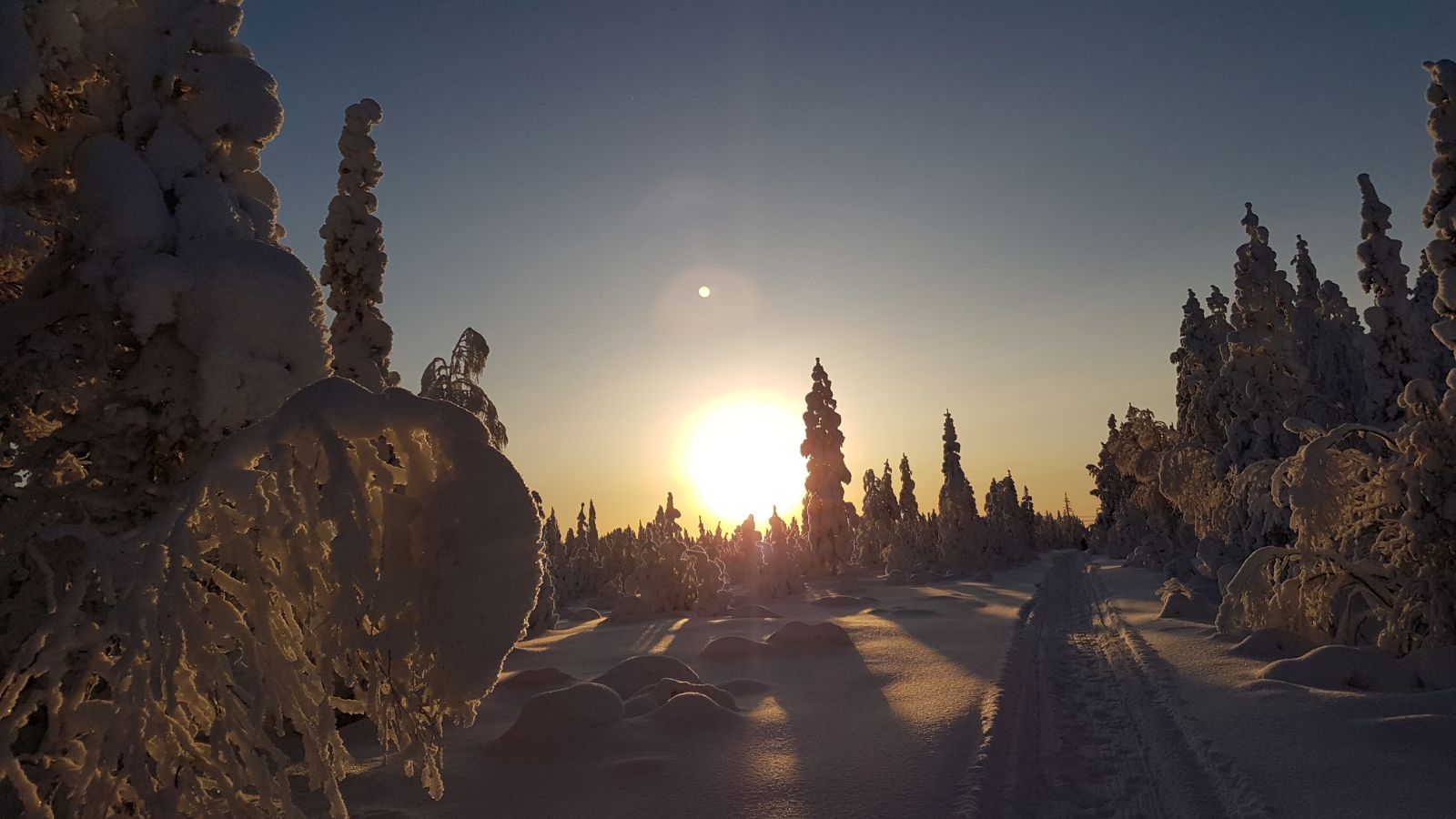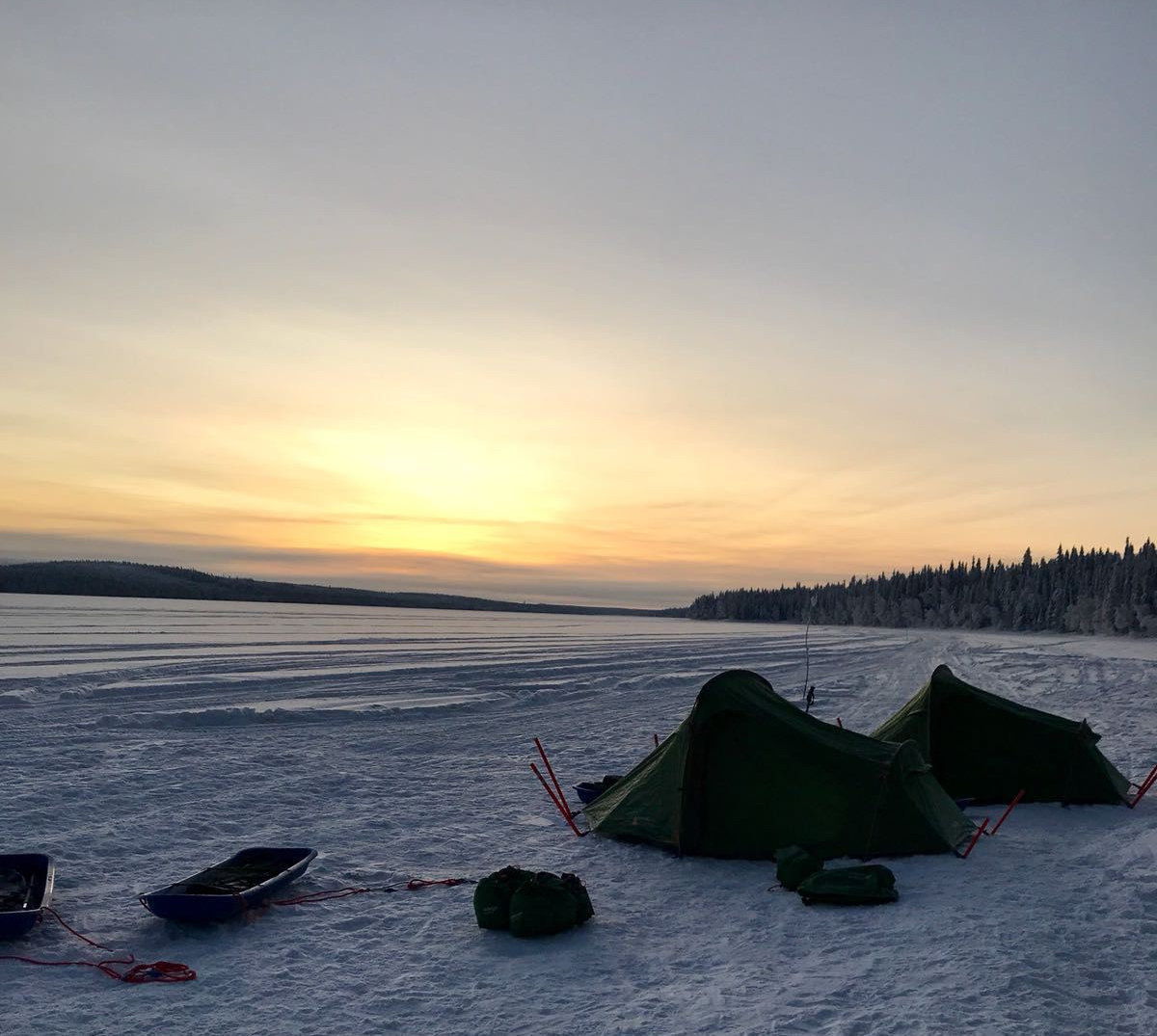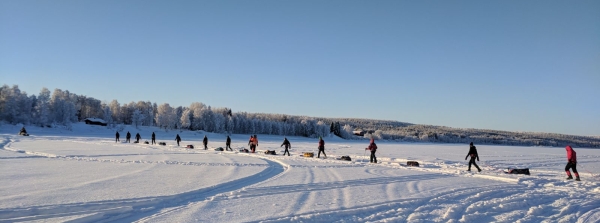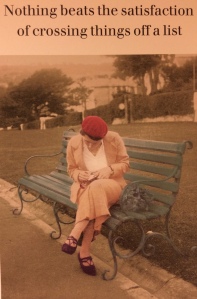I always said I didn’t like camping. Not for a summer holiday. Not at a music festival. Not even in my back garden. The mere thought of that small, enclosed space was enough to make me shudder. So when I did finally go camping, on a frozen lake in -34°C, it should have come as no surprise that things didn’t go too well.
Here’s what happened.
PART 1: TREK
Day 1 of our Arctic trek could not have been more glorious. At 9am, rigged up with harnesses, pulks and walking poles, hand warmers in our mitts and a spring in our step, we walked from our hotel down to the frozen Ounasjoki river. The sun was coming up and the sky was blue and clear. Not a breath of wind. It was bloody cold, but as we were marching at a decent pace I soon started to feel the warmth in my core working its way out to my extremities.
Everything was covered in snow. As the sun lifted, the landscape glistened as though laced with tiny crystals. The wide river was lined on both sides with delicate snow-covered birch trees, the minimalism punctuated by the occasional wooden summer house; daubs of falu red, ochre and turquoise on the otherwise white canvas.
We strode along this river for 13km, walking side by side and chatting amiably. Dry snow underfoot made the going quite easy. The pulks slid along behind us and we quickly forgot they were even there. Every hour or so we stopped to rehydrate and grab a handful of snacks. The men peed at the side of the track. The women looked away, but enviously. That was a hurdle we too would have to face before too long…
Just as the river setting might have started to get a little predictable, we turned off to join a steep path into the woods. The pulks were suddenly weighty behind us, but the scenery was so picturesque that we didn’t care. We passed through a silent village where the roofs were iced a metre thick, then on up through a forest of fir trees laden and drooping with heavy clumps of snow. At the crest of each incline, we were rewarded with the sight of the low sun slanting across unspoilt quilts of white, making the trees and even the air itself sparkle.

On we ploughed, delighting in the dazzling views. The going became trickier as we descended the wooded hillside, the track only as wide as our pulks with deep, soft drifts on either side – about thigh deep, as I found out pretty quickly when I stepped off the path. No matter, the snow was dry and brushed straight off. Here the trail undulated through the sapling firs, so we held the fronts of our pulks to navigate the steep drops while pushing through low branches poised to pour their snowy load on the unsuspecting trekker.
Eventually we emerged onto lake Sinettäjärvi – the home straight, just 8km to go. We had walked so well as a group that we’d made it to this point in record time. Legs were tired, but spirits were high. I know mine were.
As the setting sun turned the sky purple and pink before dipping to indigo, we pressed on until we saw the light of a campfire flickering within a clearing on the wooded shore. On the frozen lake itself, a row of tiny tents.
PART 2: CAMP
“Dump your pulk, grab your down jacket, spork and mug and get yourself warm by the fire!” came the instruction, and who were we to argue. Soup and stew were served. We sat around the roaring flames recounting our favourite parts of the day, with much patting on backs for such a well-walked trek.
By about 9.30pm we were ready to turn in. And this must be where something went awry for me. We had already inflated our roll mats and shaken out our sleeping bags. Nobody had more extreme-rated kit than me – thanks to Fi who had lent me her top dollar RAB expedition sleeping bag and down jacket. So, as bitterly cold as it was on the lake, all I had to do was get into the sleeping bag as quickly as possible and all would be fine.

The trick with bedtime, when you’re camping in severely low temperatures, is to get into your sleeping bag while your body is warm. It’s a total faff, especially when you have little experience of getting in and out of tents. And it’s dark. And your headtorch has suddenly decided to die.
You have to half climb into the tent, then, with your feet still outside, take off your walking boots, clean the snow off them, put them into a dry bag, and bring them into your sleeping bag with you so they don’t freeze overnight. Oh, and you’ll also need your gloves, clothes you might want to put on during the night or the following morning, and extra foot and hand warmers tucked into socks and pockets. Quickly zip up the tent. Then shuggle yourself into the sleeping bag, bring the hood up over your head (with hat), and tighten the cords until there’s just a tiny hole round your face. Then go to sleep.
Except I didn’t go to sleep.
Whether I spent too long dealing with my boots while the tent was open, or I wasn’t warm enough to start with, or I just have terrible circulation, I don’t know. But after three hours of wriggling my fingers and toes, with uncontrollable shivers spreading through my body, I began to feel sick. I realised I needed to get myself warm again, which meant climbing out of this icy cocoon, fumbling in the dark to find my boots and jacket, then stumbling back up to camp to try and rekindle the fire.
This I did at 1.30am, along with another trekker who was suffering from the cold. Thankfully Les, Rick, Jo and Neil (our brilliant trekking guides) came to our aid. They soon had a roaring blaze going and were enquiring into my exact symptoms. They plied me with tepid sweet tea – possibly the most disgusting yet welcome drink to ever pass my lips.
At 3.30am they checked my feet for frost nip and gave me the all-clear.
At 4am they layered me up with extra insulation and took me down to the tent. Now I was wearing base layers top and bottom, a fleece, a trekking jacket, a second pair of thick leggings, insulated slippers, a hat and my RAB expedition down jacket, with hand warmers tucked in every pocket. Jo bundled me into the sleeping bag with my boots, then zipped up the tent.
I had never felt so comfortable, warm and cosy. I shut my eyes and waited for sleep.
But instead of sleep, I got heart palpitations. My pulse was racing, like the beginning of a panic attack. Then the shivers began again. Numbness spread from my right hip to my foot. I bashed at the leg to get the blood moving. I bashed so hard I found a whopping bruise there the following day, but I hadn’t felt a thing at the time.
Sleep never came.
I resisted as long as I could, then reluctantly heaved myself once again from the tent and returned to the camp fire. The worst of it was having to wake the guides only a couple of hours since I’d last left them. They too had to rise and dress carefully, forcing themselves quickly out of sleep and into warmth. I felt so guilty.
I saw them conferring in a huddle and knew what was coming. With no sleep and even a mild risk that I could develop hypothermia, I would have to be taken off trail. “Extricated” they call it.
I was devastated.
I gave Sarah a hug, failing to fight the tears as I thought of her continuing this adventure without me. Then I left.
PART 3: FINISH
Extrication didn’t come without some positives. The crazed snowmobile ride up a steep wooded hillside, ducking under branches and clinging on for dear life was actually a highlight of the whole trip. As was the warm shower that followed. And the relief of knowing I wouldn’t have to face another night in a tent.
But mostly I felt such a failure.
I thought of all those people at home wishing me luck, willing me on and longing to hear how it went. What will I say?
I thought of all that training and planning and prepping. For what? I always thought this challenge would be tough, but I didn’t think I’d ever fail to complete it. And suddenly there I was back in the hotel in Rovaniemi without so much as a blister or a twinged muscle.
I thought of all the others soldiering on out there, completing the trek. How will I face them? The next day, those of us who had left the trek early (I was not alone) would take a taxi up to the Arctic Snow Hotel, stride out across the lake to meet our intrepid friends and walk the last half mile with them to the finish line. For that, I would have to summon a very different kind of courage, to bury my humiliation and enjoy everyone’s elation – graciously celebrating the achievement I had so desperately wanted for myself.
That experience was actually far more joyous than I had anticipated. Seeing Sarah staggering towards me through the snow was an amazing moment, and I felt genuine pride, delight and awe in seeing her cross the line. But I can’t say it wasn’t tinged with envy.

I knew I should console myself that it wasn’t my fault; that no amount of training could have prepared my body for that cold; that I could not have brought better kit (other than that ruddy headtorch); that this challenge was always about taking myself outside my comfort zone, whether or not I completed it, and that I had done. But in the immediate aftermath, none of that felt like any consolation at all.
The only consolation is that I was right all along: I do not do camping.

















